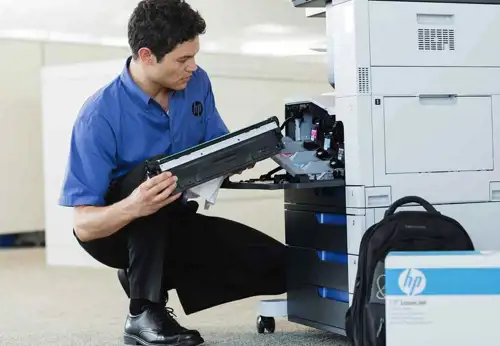Keys to a Print Consolidation Strategy
How can you make your print environment more efficient, affordable, and sustainable?
Consolidation is number one. Any organization we go into, we find that 90 percent of the printing is done by 50 percent of the fleet or less. Conversely, the other 50 percent is doing 10 percent. So focus on the top 50 percent and consolidate the bottom 50 percent.
What is a good consolidation strategy?
You need a print policy in place before you do a consolidation. The main things to consider before and during consolidation are:
- The distance that a person has to go for access to a printer
- Whether it is local or networked
- If it is color or black and white
- That the print policy is no longer than a page
- Make the policy simple to understand
Consolidation in many cases does not yield a strong financial benefit to the organization. It has other benefits, but not much volume goes to local printers. It does help with supply nightmares, it brings order to supply locations, reduces the number of orders, and reduces unused supplies. Unless you use some type of full print solution, these will help save money.
What other ways do you recommend to bring down costs?
We recommend that you consider a print anywhere solution that can turn a negative into a positive. This allows you to track what is being printed and by who, but still allows flexibility.
Having executive buy-in that shows they signed off on jobs, is easy to use and implement, and will go a long way. Executives tend to have their own local printers, so this will not affect them much.
Don’t centralize completely, but don’t have printers all over the place. Access to devices matters, but unnecessary devices need to be curtailed. We look at things like a spoked wheel, where you have your copier surrounded by your midrange printers.
The next way is to use follow-me printing. That will lower the printing by 20-30 percent, as just being aware that every print has a name on it will make users more conscious of what they are printing, making them work more efficiently.
The Acquisition of a device: rent, lease or buy?
We recommend that you should either buy outright, or lease to own, but don’t lease. If your average medium to heavy workgroup device does 500,000 lifetime prints, you want to get all of that and possibly more from the device.
If the printer does around 2,000 prints in a lease window, and the copier does 4,000, consider that your average copier is on a 5 year lease. 60 months x 4000 is 240,000. That means at the end of five years it hasn’t used half of its useful life yet. It could easily go another three years.
If you are on an evergreen lease, you basically pay for the device, give it away, and they upsell it to someone else. If you own the device, every year beyond five years is money in your pocket.
How do you know if you are saving money?
If you take a healthcare system, for example, they may say, “I’m spending more or less this year than last year, in this or that place.” It is really dependent on volume.
Volume is outside of the control of the provider. If a hospital uses an application like Epic, it is going to reduce printing. If they acquire a new hospital, they will spend more. The provider doesn’t deserve credit for reducing your bill if you are simply printing less.
The savings is because the printer fleet is printing less, not because they are doing a better job. This could also be the case for a law office using new software to track legal matters. Any company that is changing processes electronically will generally lower the print cost, at no fault or credit of the managed print company providing services.
The same is true with increasing volume. If your company purchases another company, and the print volume doubles because there are now twice as many employees, it doesn’t mean your current managed print company did a bad job. The increase was natural and expected.
How do we calculate cost?
We use an Effective Cost Per Print (ECPP). We take all of our core cost per print (not the equipment itself) and we divide that into the total volume per month. If a customer spends 50,000 dollars per month, and they generate 3 or 4 million, we divide the 50,000 into 3 or 4 to see what the real cost is.
Everything is documented in such a way as to show exactly how much is being spent, and how much is being saved. It motivates us to really manage consumables and toner cartridges that are on site as well as service tickets efficiently.
We can help you consolidate your print
If you would like to help set up a print consolidation system, we would love to be an asset to your company to ensure you take in account every factor that matters to make this successful.
More on Managed Print Services








